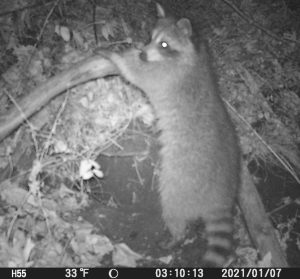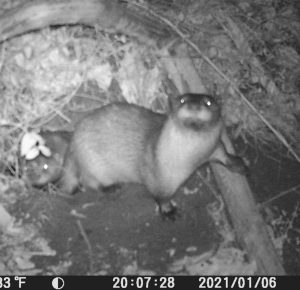By White River Steward Grace van Kan
A few weeks ago, I sat down at my computer and popped in the memory card that I’d retrieved from our trail cam at Oliver’s Woods earlier in the day. Loading up the files and clicking my way towards the images captured over the previous two weeks, there was no way to keep my excitement down. What kind of animal secrets would soon be revealed? What undercover inhabitants might I unveil?
Deer, certainly. Raccoons? Weasels? (I figured that Bigfoot or a lesser cousin would favor a more heavily wooded area—important to keep my expectations in check.)
I took a breath and opened the first image. Centered in the frame was the length of a trail, a seemingly perfect stage for creatures of a bolder nature. The first few images were devoid of animal life but provided me a time lapse of the trees’ shadows stretching across the trail. Eventually, some squirrels. A deer. A buck! A buck laying down right in the middle of the path!
Thousands of pictures of grasses subtly shifting in the wind, shadows across the path, and squirrels being squirrels.
Squirrels are fun, but it was time to re-evaluate our intentions and adjust accordingly. What were we hoping to accomplish with the trail cam?

We set up the trail cam as an exploratory tool to help us get a glimpse of the activities of our animal neighbors at Oliver’s Woods, many of whom are most active at night. In determining a prime location for the trail cam, we needed to look for evidence of animal activity: tracks, markings, fur, scat, beds.
Pointing the camera down a trail at about chest height allowed the sensor enough time to sense and capture images when larger animals, like deer, traveled down the trail. If, however, we wanted to get a glimpse of smaller animals, we needed to look for a tree hollow, perhaps a nest in a tree—or a den in the ground.
We also had to account for things like sensor sensitivity and the time interval between image captures. A trail cam with high sensitivity, set to take five pictures each time it is triggered, could potentially result in thousands of pictures of blowing leaves, or the spider who seems to know exactly how to trigger the camera while remaining utterly out of focus.
After making some adjustments to sensitivity and media type, we were confident that we could gain a better understanding of the wildlife at Oliver’s Woods. Phillip had scouted out a perfect subterranean riverfront property (hole in the ground) and we wrangled the camera into position on an adjacent tree. Lo and behold! Here was a view into the Oliver’s Woods night life!

A surprising number of animals evidently share this burrow—rabbits, raccoons, opossum, the occasional deer mouse, and many creatures just as intriguing as Bigfoot’s lesser cousin.
What’s better than Bigfoot’s cousin? A river otter. What’s even better than a river otter? Four river otters, a lengthy confab between three raccoons, a curious fox enjoying the trails—and the ability to share our observations with others.
Look for trail cam highlights on social media every Wildlife Wednesday!
As our White River steward, Grace tends to our riverine properties. She writes, “Maybe I have a weak spot for lethargic opossums and thick raccoons, but there is something truly humbling about being the first to review a fresh set of trail cam footage.” Grace’s position is funded by the Nina Mason Pulliam Charitable Trust.

Grace van Kan
White River Steward